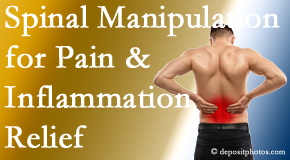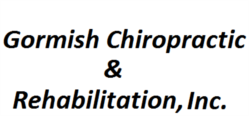Carrolltown Pain and Inflammation Helped by Spinal Manipulation
Pain and inflammation are known partners. Spinal manipulation has been used to decrease spine pain, back pain, neck pain, arm pain, and leg pain. New studies describe how the effect of spinal manipulation may extend beyond the spine to potentially control inflammation and its impact on spine pain. Gormish Chiropractic & Rehabilitation views improvement in our spine pain patients on several fronts: pain reduction, function improvement, etc. The roles of inflammation in back pain and of spinal manipulation in decreasing that pain is key to the Carrolltown chiropractic treatment plan.
BIOMARKERS
Biomarkers are quantifiable indicators of body function via tests like blood pressure, urine testing, blood testing, imaging, etc. Biomarkers can indicate normal and abnormal processes taking place in the body. In the area of back pain, researchers have been scrutinizing blood testable biomarkers like tumor necrosis factor (TNFα), interleukin-1 β (IL-1β), IL-6, IL-2, interferon (IFN), IL-1 receptor antagonist (IL-1RA), TNF soluble receptor type 2 (sTNFR2) and IL-10 to tell the story. A newer biomarker test is brain imaging. What makes brain imaging interesting? Researchers recognize that chronic back pain certainly alters the spine and believe that it changes the brain structure. Imaging of the brain is a non-invasive biomarker able to produce brain resting-state functional connectivity to analyze such variations. (1) Researchers keep thinking up new tests! Gormish Chiropractic & Rehabilitation is following these biomarker findings watchfully.
BIOMARKER TESTING FOR BACK PAIN
As low back pain continues to dominate healthcare as one of the greatest contributors to disability around the globe, researchers are studying biomarkers and their role in low back pain. Researchers wondered if there was a difference in the inflammatory profiles of nonspecific acute and chronic low back pain sufferers. They found a distinct difference in that there was a difference between pro-inflammatory and anti-inflammatory mediator levels leaning toward an overproduction of proinflammatory components in both types of patients. (2) Another study found that C-reactive protein in patients with acute non-specific low back pain and TNF-α in chronic non-specific low back pain patients were elevated. (3) These kinds of tests may help your Carrolltown chiropractor observe your back pain in a new way.
BIOMARKER TESTING OF BACK PAIN RESPONSE TO SPINAL MANIPULATION
The chiropractic treatment plan at Gormish Chiropractic & Rehabilitation currently is based on gentle spinal manipulation to reduce pain. A blood test study for biomarkers taken at the beginning of and 2 weeks after such spinal manipulative treatment found significant (though limited and diverse) alterations in the production of several biomarkers in acute and chronic back pain patients. Pain and disability scores dropped as well. (4) These are beneficial findings for the implementation of spinal manipulation for back pain. Gormish Chiropractic & Rehabilitation is excited to learn more about biomarker-level changes with Carrolltown spinal manipulation!
CONTACT Gormish Chiropractic & Rehabilitation
Listen to this PODCAST with Dr. James Cox on The Back Doctors Podcast with Dr. Michael Johnson as he discusses how use of chiropractic spinal manipulation and Cox® Technic Flexion Distraction may well surpass pain relief.
Set up your Carrolltown chiropractic appointment now. Daily, pain and inflammation come to our clinic together. Our treatment helps decrease their influence on the lives of our Carrolltown chiropractic patients.

